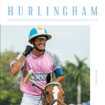From the Royal Stables to the Game of Kings – Faradic Impulse Therapy by Transeva
By Victoria Elsbury-Legg
In recent seasons there has been a huge increase in the way in which players maintain their fitness pitch-side and warm themselves up pre and post-match. From stretching to jogging and all manner of other exercises in between, with many players now frequently being seen cooling down post-game with the help of fitness trainers and physios.
Pony welfare and fitness is also a much talked about topic, with players keen to keep their ponies equally as flexible and at the very top of their game. One method which is used by an increasing number of players is Faradic Impulse Therapy by Transeva.
This is a method based on ‘Rhythmic Muscular Contraction’ which works in both humans and animals helping with the recovery of sprains, strains and contusions. A hand-held electrode emitting a low current electrical impulse to the body works by contracting the muscle, thus increasing blood flow to the area, which brings with it a large supply of oxygen to nourish the injured area – creating a ‘Faradic wave.’ Alongside this, the circulation removes metabolic waste products preventing congestion in the tissue and allowing the muscle to heal more rapidly.
It was in the late 1940’s after World War II that Sir Charles Strong masterminded a machine he called ‘the strong box’ and began to treat equines with the Faradic current. Several decades later in 1980 he created the first Transeva machine which was used with such success in the Royal Stables that he was awarded a knighthood by Queen Elizabeth II. Sadly shortly after this accolade Sir Charles passed away, but determined to keep his work alive the daughter of a South African racehorse trainer – Winks Greene continued and built on his work, creating the Transeva model that is in production today.
Taking up the reins and putting this treatment to work in the polo world has been the inspired vision of Petra Sones (FIT4Polo) who observed the success of the treatment on one of her daughter’s polo ponies ten years ago. Following extensive research and assisting a student of Winks Greene, Petra purchased her own machines and set up a maintenance programme for competition horses. As she explained, ‘the treatment is designed to keep ponies muscles balanced, supporting joints and helping to alleviate soft tissue damage through inadvertent trauma sustained during matches due to ride offs or collisions or impact with balls/mallets. Each treatment covers all the major muscle groups and helps with recurring back problems caused by tight hamstrings and/or shoulder soreness as well as treatment of the gastrocnemius muscle which is instrumental in the movement of the hock joint necessary to efficient turning and stopping.’
With her mobile service now being used across the polo world by high goal professionals through to low goal patrons, all of whom want to achieve the full potential of their ponies through a regular maintenance schedule, her journey has been one of persistence, as Petra is determined that this treatment should not return to obscurity.
For more information email Petra at: petrasones@gmail.com


